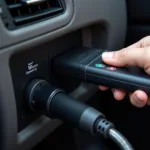The Ford Transit has been a reliable workhorse for businesses and individuals for decades. As with any vehicle, it’s crucial to stay ahead of potential issues. This is where OBD2 scanners come into play, offering a window into your Ford Transit’s engine control unit (ECU) and providing valuable diagnostic information. This guide delves into the world of OBD2 scanners specifically for Ford Transit vans, providing you with the knowledge to understand your vehicle’s health better.
Understanding OBD2 and Your Ford Transit
OBD2, or On-Board Diagnostics II, is a standardized system implemented in vehicles from 1996 onwards, including your Ford Transit. It allows you to communicate with your van’s computer, accessing data from various sensors that monitor engine performance, emissions, and other vital systems.
An OBD2 scanner acts as the interface between you and your Ford Transit’s ECU. By plugging into the OBD2 port, usually located under the dashboard on the driver’s side, you can retrieve diagnostic trouble codes (DTCs), monitor live data, and even reset certain warning lights.
Why Use an OBD2 Scanner on a Ford Transit?
For Ford Transit owners, especially those with older models or high mileage vehicles, an OBD2 scanner can be an invaluable tool. Here’s why:
- Diagnose Engine Problems: Identify issues like misfires, fuel system problems, or sensor failures by reading DTCs.
- Monitor Performance: Track live data such as engine speed, coolant temperature, and oxygen sensor readings to assess your van’s performance.
- Check Emission Readiness: Ensure your Transit is ready for emissions testing by checking the status of its emission monitors.
- Save Money: Early detection of problems can prevent costly repairs down the line.
- DIY Maintenance: Perform basic maintenance tasks like resetting the check engine light after repairs.
Choosing the Right OBD2 Scanner for Your Ford Transit
Not all OBD2 scanners are created equal. Some offer basic functionality while others provide advanced features like live data graphing, manufacturer-specific code definitions, and even bi-directional control, allowing you to test certain components.
When selecting an OBD2 scanner for your Ford Transit, consider the following factors:
- Compatibility: Ensure the scanner explicitly states compatibility with Ford vehicles and the specific model year of your Transit.
- Features: Determine what features are essential for your needs, such as code reading, live data, and special functions.
- Budget: Prices can range from affordable basic scanners to high-end professional-grade tools.
- User-Friendliness: Opt for a scanner with a clear display, intuitive interface, and comprehensive documentation.
Common OBD2 Codes on Ford Transit Vans
While an OBD2 scanner can read numerous codes, here are some common ones you might encounter on your Ford Transit:
- P0401: EGR Insufficient Flow
- P0171: System Too Lean (Bank 1)
- P0300: Random/Multiple Cylinder Misfire Detected
- P0128: Coolant Thermostat (Coolant Temperature Below Thermostat Regulating Temperature)
- P0420: Catalyst System Efficiency Below Threshold (Bank 1)
It’s important to note that these are just a few examples, and the specific codes will depend on the year and model of your Ford Transit. Always refer to a reliable OBD2 code database or your vehicle’s service manual for accurate interpretations.
Beyond Diagnostics: Using OBD2 for Enhanced Control
Modern OBD2 scanners offer advanced features that go beyond basic diagnostics, giving you greater control over your Ford Transit. For instance, some scanners enable you to:
- Program Keys: If you need a new key fob for your Transit, certain scanners can program it without needing a dealership visit.
- Reset Service Lights: After performing maintenance like an oil change, use the scanner to reset the service light yourself.
- Perform DPF Regeneration: Force a Diesel Particulate Filter regeneration cycle if your Transit is equipped with a diesel engine.
Conclusion
Investing in an OBD2 scanner for your Ford Transit is an investment in your peace of mind. It empowers you with the knowledge and tools to understand, diagnose, and potentially even fix minor issues with your van. From reading and clearing trouble codes to monitoring live data and performing special functions, an OBD2 scanner allows you to take control of your vehicle’s health and maintain its performance for years to come.
For further information on specific OBD2 topics related to your Ford Transit, explore these resources:
- How to convert obd1 to obd2 toyota
- EEC IV to OBD2
- 1992 f150 obd1 or obd2
- Ford fuel trims pre obd2
- 38 pin to obd2
Need help with your Ford Transit diagnostics or have further questions? Don’t hesitate to reach out! Contact us via WhatsApp: +1(641)206-8880, Email: [email protected]. Our 24/7 customer support team is here to assist you.


